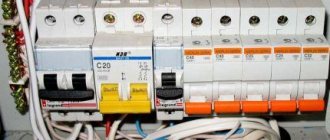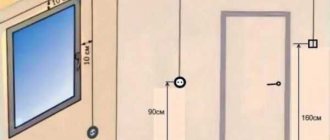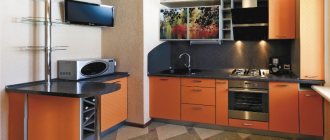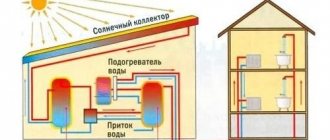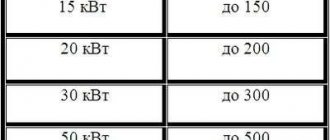A batch switch is the simplest type of device for turning off/on electricity. This is a switch, familiar from Soviet times at the entrance to the apartment in the switchboard. Often also used in electrical installations, control panels, where a manual control principle is required. For homes, the device is positioned as less modern, without the function of protecting wiring or auto-de-energizing during overloads. Nevertheless, packages fulfill their tasks, which is why they can still be found in electrical panels of houses. Replaced with modern and compact automatic circuit breakers (CBs) with a protection function.
LIMIT AND BATCH SWITCHES
Limit switches (LS)
- close and open an electrical circuit when a certain event occurs and (or) ends. The simplest example of using such a device is the well-known button for turning on the electric lighting of a refrigerator.
According to the operating principle, limit switches can be divided into:
- contact (when the triggering event is caused by mechanical contact of two bodies and is initiated by the resulting pressure);
- non-contact (as a rule, they consist of a radiation source and a photocell or magnetically controlled contacts).
Some types of limit switches, in addition to normally open contacts, also have normally closed contacts. The second pair of contacts allows you to monitor the connection status. The absence of a signal transmitted through normally closed contacts indicates damage to the electrical circuits.
Batch switches (PB)
or bags - a separate type of electrical appliances. They are designed for use in AC and DC circuits. However, there are significant limitations in their use:
- in 220V networks, the current should not exceed 100A;
- in 380V networks, the same value is limited to 60A.
The main advantages of packet switches include their compactness compared to switches designed for the same power. The main current ratings for which such devices are currently produced are 10, 16 and 25 Amperes.
Device of batch switches.
The package design includes:
- contact group;
- switch.
Inside the housing, on a square bushing, there are movable contacts. The sleeve itself is made of insulating material. Terminals of fixed contacts protrude from the walls of the housing. The circuit between them is closed by turning the switch.
The package switch body itself is made of individual washers, tightened into a monolith using pins. The angle of rotation of the handle is adjusted by the spring of the quick shift mechanism and stops in the upper switch washer.
PVs are available in single-pole, double-pole and three-pole versions. The latter are most often used to start three-phase motors.
A typical switch has four positions - two positions in which the circuit is closed and two positions in which the electrical circuit is open. However, by increasing the number of positions you can get a batch switch.
Application area.
In older homes, this is one of the main types of switches. But even now, in the entrances of houses, these electrical appliances are installed in distribution boxes and panels. In addition, they are used:
- in control panels;
- at electrical substations;
- in the driver's cabins of units powered by electricity (tower cranes, excavators and other electric power machines).
Package switches and switches can be produced in various designs. As a rule, the housing material is plastic or silumin. The number of insulating washers, depending on the purpose and switching purposes, ranges from 1 to 12, but on request you can assemble a switch with almost any number of handle positions.
2012-2020 All rights reserved.
The materials presented on the site are for informational purposes only and cannot be used as guidelines or regulatory documents.
What are they for?
Purpose of this device:
- Boxes for electric machines. Control the load by turning off the network;
- At substations. For control panels. Convenient reading;
- For electric power equipment. Monitoring the activities of cranes and excavators.
Purpose of package switches
A batch switch is a manual device that is designed for switching (turning on/off) small load currents. Packers are used in electrical networks of alternating current up to 660 V and direct current - up to 440 V.
They are installed on distribution board panels, as well as in cabinets as input switches.
A batch switch is a device for switching electric current in networks. It has a manual drive with a switching device in the form of an insulating board, on which moving contacts isolated from each other and fixed contacts with terminals are fixed.
In order to turn the batch switch on or off, you must turn its handle 90°. This manipulation fixes the moving contacts in the desired position using a spring mechanism.
Thanks to the presence of locking protrusions that limit the rotation of the spring mechanism and with it the moving contacts, the package switch has a clear position fixation when the handle is turned 90°.
Depending on the degree of protection, package switches are classified into three types of manufacture:
The open package switch is intended exclusively for installation in dry, dust-free rooms with no risk of fire and other protected places (boards, boxes, niches) that prevent accidental touching of fixed contacts.
The protected design of the packet switch implies the presence of a plastic shell. It protects the bag not only from accidental contact, but also from foreign objects getting on live parts.
The hermetic design of the bag is realized by protecting it with an aluminum or plastic case, which prevents moisture from getting inside it.
Structural designation of bags
In abbreviated form, package switches are designated by the letters PV, and switches by the letters PP. The number following the abbreviation is the number of poles, and after the hyphen is the switched current in amperes at a voltage of 220 V.
Based on the type of mounting, package switches are available in the following versions:
- I) the packet mount is located behind a panel up to 4 mm thick and is performed with a front bracket, external wires are connected from the back;
- II) the fastening is placed behind a panel up to 24 mm thick and is performed with a front bracket, external wires are also connected from the back;
- III) the fastening is located inside the cabinet and is performed with a rear bracket, external wires are connected from the front;
- IV) fastening is carried out by the body.
The design of the package switch consists of two main components: the switching mechanism and the contact system. Depending on the number of working poles (1-4), it contains several switching packages.
A separate package contains movable and fixed joints with fiber washers that help extinguish the arc. Movable spring contacts are located on the rotary pin.
It, in turn, is made of insulating material, which, when rotated, locks 90 degrees for each turn. Fixed contacts, shaped like knives, are located in plastic washers.
Similar materials on the site:
Why change?
If the question is whether it is worth changing to AB, even if the switch is working, then the answer is unequivocal - yes. This is not only recommended and desirable, but also, one might say, mandatory for the following reasons:
- protection can only be provided by AB;
- connect another automatic protective shutdown device (RCD, RCBO), which is mandatory, for example, in the absence of grounding, when using boilers (powerful electrical appliances) in the house, and, however, it is always, of course, more expedient and convenient with AV;
- if there is a DIN rail, then the modular placement of AB, RCD, RCBO is extremely convenient, although there are shields with it bolted to the box body.
Classic connection scheme
When implementing such a scheme, the following actions are performed:
- When you press the “Start” button, the contacts close and voltage is supplied to the load.
- When you press the “Stop” button, the starter contacts open and the voltage supply stops.
You can connect heating elements, electric motors, and other devices as a load. A normally open 220V electromagnetic starter can be used to turn on absolutely any load.
The power part of the circuit includes:
- Contacts for connecting three phases – “A”, “B”, “C”.
- Circuit breaker. It is installed between the power source and the input of the 220V 25A electromagnetic starter. The fact is that 380V is the phase-to-phase voltage, and if you measure between zero and any of the phases, it will be equal to 220V.
- The load is a powerful consumer of electricity (motor, heating element).
The entire control circuit is connected to zero and phase “A”. The circuit consists of the following components:
- Start and stop buttons.
- Reels.
- Auxiliary contact (switched on parallel to the start button).
Design and principle of operation
The main purpose of package switches is to timely turn on and off electrical contacts when working on lines with low voltage. Alternating current has an operating voltage of up to 380 volts, and direct current - up to 220 volts. The operating frequency is 50 Hz and above. These devices do not provide highly effective protection, however, due to their low cost, they are in high demand among consumers.
Packets are equipped with several operating poles, which ensure the inclusion of the appropriate number of switching packages with stationary and moving contacts. Stationary contacts are made in the form of knives and installed in plastic washers. The moving contacts are fixed on an insulated rotary pin. The appearance of the bag resembles a small barrel with a handle and leads for wires. The switching speed is regulated by specially installed springs, regardless of the speed at which the handle rotates.
The operating principle of the device is quite simple. When the handle is moved to the desired position, the spring is tensioned. The created force affects the spring washer, which rotates all the way and goes into the on state. Clamps installed on the cover stabilize the washer in a certain position. When the washer is rotated, the contacts connected to it are activated, and electric current begins to flow into the network.
Packets have a design feature in the form of terminals without insulation, which are energized when connected to the network. Therefore, before starting electrical installation work, they must be turned off to avoid electric shock.
Design features and principle of operation
Bundled three-pole switches are equipped with four plastic discs. Each of these disks has a cutout into which terminals are installed. These parts look like knives. There is also a special spring contact that connects and disconnects individual terminals.
The spring is launched by moving a lever that controls the functioning of the entire system, the mechanisms of which are tightened with one another through a pin connection.
Design of a packet switch indicating the main elements marked with number positions
The design of the switch consists of the following elements:
- moving contact;
- disk;
- blade inserts for discs;
- studs used for connection;
- a handle that controls the operation of the device and is connected to a spring mechanism.
Due to their high response speed, the devices effectively extinguish the resulting electric arc.
Similarity to the operation of an RCD: a spring mechanism instantly cuts off the supply of electrical energy. The principle of operation of switches is in many ways identical to the functioning of switches, however, the devices have significantly smaller dimensions.
Despite their high response speed, packet switches wear out too quickly. Due to the rapid response to network faults, most of the mechanisms available in the design cannot withstand the pace of work.
An ordinary switch can, on average, withstand current interruptions about 100 times. Highly specialized machines have a validity period that is 2 times longer—about 200 times. In this case, no more than 50 cycles of changing the operating mode should occur within an hour.
Single-phase package switches are manufactured in several versions: 10 and 25 A with a voltage of 220 V. Two-phase - for 10 and 20 A.
Three-phase packetizers of some models can be installed for 380 V networks, but their current strength must be equal to 16 and 6 A.
There are often universal packet switches that simultaneously perform the functions of switching off and switching current.
The 16 A package switch, model VP 2-16, is small in size
The operating modes of packetizers are controlled in the following sequence.
After changing the position of the lever, the direction of the poles changes. Based on it, the current supply either stops (when the terminals are disconnected) or begins to flow through the contacts when they are connected.
Automatic backup
Sometimes they install a backup machine, but this is not necessary, especially when the line is further protected by an RCD+AV or RCBO. If you decide to install such a device, then you are guided by the standard rule: the optimal rating is less than that of the main device and more than that of group switches further down the line (for example, if there are RCD+AV combinations to protect the boiler, etc.). Example: the main device is 32 A and the backup device is 25 A, if the group devices are 20 A. If such a ratio is impossible, then at least the value should be no lower, that is, correspond to the input AB. In this case, the backup will have the role of a disconnecting device (during line repairs); in emergency conditions, it will snap off simultaneously with the main device.
Types and purpose of packets
The types of package switches are closely related to the degree of their security. The scope of application of a particular device depends on this factor. Usually they are mounted in iron panels, boxes and other most suitable places. The packet switch does not tolerate dust at all and react negatively to high levels of humidity. The negative impact of such factors can lead to damage to the contacts.
The protected package switch is enclosed in a special shell, which serves as the device body. In this design, the device can be installed outside the electrical panel, since the design provides reliable protection from dust and moisture. Electrical safety also increases, since the possibility of accidentally touching live parts of the device is eliminated.
There are sealed models made of aluminum and plastic materials. This gives the products high strength and improves other technical characteristics. These bags are designed for use even in very damp areas. They are often used outdoors, mainly in private homes.
Depending on the type of fastening, bags are manufactured in several versions:
- View 1. The device mount is located behind the 4 mm panel and is latched using the front bracket. External wires are connected from the rear.
- View 2. The fastening is located behind the panel, 24 mm thick. The front bracket is used for latching. The connection of external wires is also made from the rear side.
- View 3. The fastening is installed inside the cabinet, fixation is carried out using the rear bracket. External wires are connected from the front.
- View 4. The bag is fastened directly to the body.
Varieties
Depending on the level of protection from the effects of negative environmental conditions, the following types of package switches are produced:
- open;
- closed;
- sealed.
Exposed switches are unprotected. They are installed in distribution panels. Also, metal boxes can be the place of their attachment. The disadvantages of such devices are sensitivity to dust and low resistance to high humidity.
Sealed switches are made from an alloy of aluminum and polyvinyl chloride. The advantages of such devices are durability, strength, reliability, moisture resistance, and tightness.
Main types and types of bags
Bags are classified according to different criteria:
- at the location where external electrical cables are connected to the panel (front, rear connection);
- according to the degree of protection of internal structural elements from negative environmental factors (open, protected, sealed devices are distinguished);
- according to the design features of the switches (packet-cam, drum).
Despite the wide variety of package switches and switches, they have common technical and operational characteristics and similar disadvantages.
Thus, the resource of the spring mechanism is designed for approximately 103 power outages. There are wear-resistant models that perform 203-1000 shutdowns. The main condition: the frequency of operation of the mechanism should not exceed 50 within 1 hour.
Image gallery
Photo from
Bags in an unprotected housing are perfect for installation in electrical panels. The main thing is that the panels, niches or drawers are located in dry rooms and are securely closed from dust, moisture, and splashes. If these conditions are not met, there is a high probability that the device will quickly fail due to rust, dust particles or damaged contacts
Package switching and switching devices, closed by a housing, do not have to be installed in niches and panels. Their outer shell provides good protection against dust and accidental damage. Manufacturers took special care to ensure that no dirt particles got on the contacts, and that it was impossible to touch the current-carrying elements without disassembling the device
These are devices in splash-proof and explosion-proof housings. The outer shells of the devices are made of high-strength plastic and aluminum. The materials are extremely durable and do not corrode. The cases are designed so that drops of moisture and dust particles do not get inside the mechanism. Such devices can be installed in any conditions, even outdoors
Packages differ in the installation method. They are divided into stationary and withdrawable with plug-in contacts. Devices are selected depending on convenience and specific operating conditions. The main thing is that the technical characteristics of the devices correspond to the network voltage, the number of directions and poles, and the rated current
Open package switch
Protected and unprotected packets
Bag in a sealed case
Modern fixed package switch
Product markings may include the following alphabetic and digital symbols:
- “B” – switch;
- “P” – switch;
- “P” – batch;
- “G” – sealed;
- numbers 1-4 – number of poles;
- “N” – direction (2, 3, 4, and also “R” – reverse).
The marking of devices indicates the degree of protection, type of placement, installation features, rated current. Sometimes you can find abbreviations “sil.” and "pl." They are used to indicate the housing material (silumin, plastic). For example, the marking of the device GPPM-2-60/N2 stands for 2-pole 60-amp sealed packet switch for 2 directions.
When will replacement be required?
The service life depends on how the locking washer looks.
This is the main part of the switch; if it fails, the device requires replacement. Packet switches cannot be repaired. If damaged, immediate replacement is required. But you won’t have to debug the device throughout the entire period of operation.
Despite the decline in popularity of such models, manufacturers still delight with new developments. Each time the products are improved and shortcomings are eliminated.
And if package switches are less common in everyday life, then in production you simply cannot do without them. Compactness and ease of installation, resistance to damage, ease of maintenance are the main advantages of the package switch.
It is worth paying attention to the models: Legrand (France), Iek (Russia), ABB (Sweden, Switzerland). The products of these companies are characterized by reliability and quality.
Starting the motor in reverse
For individual equipment to function, it is necessary that the motor can rotate both left and right.
The connection diagram for this option contains two MPs, a push-button station or three separate keys - two starting ones “Forward”, “Back” and “Stop”.
To implement this option, another signal circuit is added to the circuit with one MP. It includes the SB3 key, MP KM2. The power part has also been slightly changed
From short circuit the power circuit is protected by normally closed contacts KM1.2, KM2.2.
The circuit is prepared for operation as follows:
- Turn on AB QF1.
- The power contacts of MP KM1, KM2 receive phases A, B, C.
- The phase that supplies the control circuit (A) through SF1 (signal circuit breaker) and the SB1 “Stop” key is supplied to contact 3 (keys SB2, SB3), contact 13NO (MP KM1, KM2).
Next, the circuit operates according to an algorithm depending on the direction of rotation of the motor.
Engine reverse control
Rotation begins when the SB2 key is activated. In this case, phase A is supplied through KM2.2 to the MP coil KM1. The starter starts turning on with the closing of the normally open contacts and the opening of the normally closed ones.
The closure of KM1.1 provokes self-catching, and the closing of the KM1 contacts is followed by the supply of phases A, B, C to identical contacts of the motor windings and it begins to rotate.
Before starting the motor in the opposite direction, it is necessary to stop the previously specified rotation using the “Stop” button. To twist in the opposite direction, you only need to use the KM2 starter to change the dislocation of some two supply phases
The action taken will disconnect the circuit, control phase A will no longer be supplied to the KM1 inductor, and the core with contacts will be restored to its original position by means of a return spring.
The contacts will disconnect and the voltage supply to the motor M will stop. The circuit will be in standby mode.
It is launched by pressing the SB3 button. Phase A through KM1.2 will go to KM2, MP, will work and through KM2.1 will be self-retaining.
Next, the MP, through contacts KM2, will swap the phases. As a result, the motor M will change the direction of rotation. At this time, connection KM2.2, located in the circuit supplying MP KM1, will disconnect, preventing KM1 from being turned on while KM2 is operating.
Power circuit operation
The responsibility for switching phases to redirect the rotation of the motor rests with the power circuit.
The white wire connects phase A to the left contact of MP KM1, then through the jumper it goes to the left contact of KM2. The starter outputs are also connected by a cross-jumper and then phase A of the motor is supplied to the first winding through KM1
When the contacts of MP KM1 are triggered, the first winding receives phase A, the second winding receives phase B, and the third receives phase C. In this case, the motor rotates to the left.
When KM2 is triggered, phases B and C are relocated. The first goes to the third winding, the second to the second. There are no changes in phase A. The engine will begin to rotate to the right.
More modern analogues of the device
The old package switches have been replaced almost everywhere with automatic machines. This is logical, because the requirements for energy consumption and durability of devices have changed. Nowadays, RCDs (residual current devices), automatic and differential circuit breakers, and contactors are widely used.
Option #1: residual current device
The device is designed to prevent current leaks. It reacts to differential current, which contributes to overheating of electrical cables, which can lead to a short circuit and fire of the wiring. Leaks can also cause electric shock to a person.
The device cannot be considered a 100% analogue of a bagger, however, when combined with a circuit breaker, it performs even more functions
An RCD must be installed to avoid the risk of electric current leakage if it begins to pass by consumer devices. The device functions as a leak indicator, which simply turns off the electricity in case of problems.
The device itself does not protect against overloads or short circuits. This is only possible if it is connected in combination with a circuit breaker.
Option #2: circuit breaker
These devices replaced the batch switch. They perform the same functions, but are more convenient to use, durable and wear-resistant. Automatic switches can also be one-, two-, three-, four-pole. They differ in the type of drive (it can be manual, spring, motor), type of connection and other technical and operational characteristics.
A selective circuit breaker does not require additional power to make or open its contacts. The device is electro-mechanical and is designed to perform its functions in the best possible way.
Automatic switches are classified and marked in accordance with GOSTs 9098–78 and 14255. These documents establish requirements for the technical characteristics of devices.
Option #3: differential machine
This is a combined machine that simultaneously performs the functions of two devices - an RCD and a circuit breaker. It perfectly replaces the bag, is suitable for household electrical networks and is successfully used in enterprises.
Differential circuit breaker is a “2 in 1” device: a circuit breaker and an RCD located in a common housing. It flawlessly copes with the tasks of both devices and at the same time is compact and easy to use.
The differential circuit breaker prevents leaks, short circuits, and minimizes the risk of electric shock. The design of the device includes thermal and electromagnetic releases. The first prevents overloads in the network, and the second is needed to turn off the electric current in the event of a short circuit.
Option #4: contactor - a type of electromagnetic relay
The device is necessary for remote control of on/off modes of electrical circuits. The devices do not operate in the event of a short circuit and are designed for rated currents only. This is their main difference from circuit breakers.
The devices are characterized by exceptional electrical and mechanical wear resistance. They are installed in the mechanisms of elevators, vehicles, and used in enterprises
In modern residential buildings, outdated package switches are rarely installed. More popular options are difavtomat or RCD in combination with a circuit breaker. But there are cases when a good old bag can be indispensable, for example, if you need to turn off the current supply during electrical installation work.
Cable Requirements
You can already understand that not every cable is suitable for connecting such equipment. This is logical, since under heavy overloads it will simply burn out and can cause equipment failure or a fire. Therefore, when choosing a cable for an electric stove, you should rely on the following important characteristics:
- Rated voltage;
- material that serves as the basis for wire cores;
- cable section;
- ease of connection to the device.
If we take the rated voltage for devices of well-known brands, then its value must be exactly no less than that provided by the conventional electrical network where the device needs to be connected. Now let's say a little more about the described indicators.
Probably one of the most important aspects that will play a role is the material used to make the cable cores. It's best if they are copper. This metal itself can be soldered if necessary. And the copper power wire is more flexible than its aluminum counterpart. But the cost of a copper solution will be higher. If the choice falls on an aluminum analogue, then you need to understand that its installation should not be carried out in materials that burn. You can find out what the electrical wire is made of thanks to special markings on the product itself.
If we talk directly about numbers, then, as a rule, most solutions from well-known brands (Samsung or Electrolux) are designed for electricity consumption of just under 4 kW. For this reason, the safety margin of the wire needs to be selected based on power somewhere with a focus on this indicator.
To ensure that the device operates as safely as possible, you should also pay attention to the following points:
- If you need to lay the cord directly from the panel to the electric stove, a cord with a standard cross-section of 1.5 square meters is sufficient. mm.
- If other electrical appliances will be connected between the device and the panel, then you should have a cable with a cross-section of at least 2.5 square meters. mm. This option will provide the necessary reserve in case of connecting some other household appliances.
Another important parameter is the phase connection. It will depend on the number of cores in the cable. The wire can be 3 or 5 wires. The number of cores will depend on the power supply network in the room. And it can be either 1-phase or 3-phase. If the first option, then you will need to purchase a wire with three cores, and if the second - with five.
You should also find out whether the purchased equipment supports the type of connection that was selected. For example, stoves with a power of up to 5 kW are usually connected to a 1-phase network, while more powerful ones have a 2 or 3-phase connection. The type of cable that can be used will also be important, but more on that below.
Device
The package switch consists of the following main parts:
- housings;
- contact system;
- switching mechanism;
- handles.
Package switch design
The body is made of carbolite, silumin or durable and self-extinguishing plastic. The contact system consists of fixed and movable sections. The fixed section has 2 screws to which the power wires are connected. The moving contacts are spring-loaded and have spark-extinguishing washers. The sections are assembled on a special pin, with the help of which they are fastened in the right place. The pin is equipped with a handle for performing the necessary manipulations manually.
Operating principle - the product can only perform the function of turning on and off, and may have intermediate positions for carrying out various operations. For example, when starting an asynchronous motor at a certain position of the handle, it will receive power, be connected in a star, delta, according to a double star circuit, or be completely de-energized. To put the bagger into operation, you need to turn the handle to a certain mark; there are corresponding marks on the body. This allows you to fix the moving contacts in the desired position. A spring mechanism is used for this.
The batch switch ensures that the object is disconnected from the electrical supply. network, but the power itself cannot be disconnected.
The best way to tell about the types of bags is their labeling.
Symbol
Symbol structure:
G P X X – XXX XX XX XXXX X
1 2 3 4 5 6 7 8 9. where:
- hermetic (G) without a letter - standard design;
- batch (P);
- switch (B), switch (P);
- number of poles (from 1 to 4);
- rated current value in amperes (6.3; 10; 16; 25; 40; 63; 100; 160; 200; 250; 400);
- symbol for the number of directions (H2 – two directions; H3 – three; H4 – four; P – for engine reverse);
- climatic modification and placement category (U2; U3; U4; T2; T3; T4; HL2; HL3; HL4; UHL2; UHL3; UHL4);
- degree of protection and housing material (IP00 - open version; IP30 - protected version; IP56 sil. and IP56 pl. - sealed version, where sil. - silumin housing; pl. - plastic);
- fastening method (1 – fastening with a front bracket with installation behind a panel up to 4 mm thick; 2 – fastening with a front bracket with installation behind a panel up to 25 mm thick; 3 – fastening with a rear bracket with installation inside the cabinet; 4 – fastening by the body (only for products with degree of protection IP30 and IP56).
Conventional graphic designation of package switches on electrical diagrams
From this symbol you can clearly see what kind of bags there are. This symbol is indicated in the passport for a specific product, its case and in the corresponding technical documentation.
Appearance of package sealed switch
Description
All package switches are low-voltage electrical devices that perform switching in electrical circuits. Structurally, a packet switch can have one, two or three poles. Colloquially among specialists, these devices are also called packetizers.
A standard packet switch consists of a housing, a handle, a switching mechanism and a contact system, which includes movable and fixed contact groups. Extinguishing the electric arc that occurs under load during switching is carried out by a spring-loaded quick switching mechanism. The main difference between a packet switch and a differential circuit breaker is the impossibility of disconnecting it from the supply network. When large voltage drops occur, the packet can simply burn out.
The main advantages of these devices are their compact size and the availability of a large switching resource. They provide a high degree of electrical safety during switching operations. Previously, small package switches were installed in every apartment or house. Currently, they are being replaced by two- or three-pole circuit breakers.
Three-phase and two-position switches of modular type
Batch switch device
Devices of this class are installed in three-phase networks and allow switching the power supply to powerful asynchronous electric motors. In particular, they are used to switch a set of 3 windings from one switching circuit to another: from delta to star and back.
Switching the connection modes of the stator windings is necessary to reduce the magnitude of inrush currents in the power circuits - to “facilitate” starting.
Two-position modular switches are represented in the range of electrical products by cam-type batch switches. They are widely in demand in the following situations:
- when installing control panels for AC and DC power equipment;
- in modern power grids equipped with automatic backup systems;
- for switching winding circuits and operating modes of electric motors, as well as for controlling lighting from several points at once;
- to select suitable operating conditions for transformer substations (TS), as well as to optimize the operation of the switching equipment serving them;
- when choosing the desired mode for heating equipment and welding units.
Three position packet switch
One of the varieties of two-position switches are devices that, in addition to two extreme positions, also have one central one. Formally, they are classified as three-position switches with one neutral position, but in circuits they are still used as two-terminal devices.
To make it easier to select the required sample of a switching product suitable for specific conditions, the main technical parameters are indicated on the housing:
- type of switching device;
- rated current for which its operating contacts are designed;
- electrical switching diagram (switching table);
- category of protection from climatic influences.
Installation and connection features
Connection diagram
Before installing double-pole switches directly at their destination, it is important to determine the conditions for arranging wire lines at a specific facility (in a private house or apartment). In this case, there are two options for laying out a bundle of conductors, laid either covertly or openly
When laying hidden in the walls, first special grooves (grooves) are made, into which a corrugated hose with a set of conductors is then placed.
In this case, the two-terminal circuit itself will have to be placed secretly - to make a special niche for it in the wall, the size corresponding to the diameter of the fastening elements. To prepare it, you will need an electric drill with a special “crown” type attachment.
Recessed switch
It is also necessary to prepare a plastic case or mounting box in which the two-position switch will be fixed. When carrying out these operations, the following generally accepted rules are adhered to:
- Before starting work, completely de-energize the entire apartment or this branch from the distribution panel, turning off the corresponding linear circuit breaker.
- Prepare a rough diagram of the switch placement and wiring to it.
- After drilling a hole of a suitable diameter in the wall, place the landing box in it, securing it with spacer screws.
- Install the switching device itself into the finished round niche.
- Connect the appropriate conductors to its terminals and secure the housing with fastening hardware.
Installation of the surface switch
The procedure for installing the device open is as follows:
- The zone of its fixation on the wall is marked.
- At the selected location, an additional support made of wood or plastic (socket box) is attached with screws.
- The product is fixed on it using hardware of suitable size.
The procedure for connecting conductors to the terminals of the changeover device is the same as for hidden installation. With this installation method, the supply wires can be placed in a special plastic channel called a cable channel.
The areas of application of two-way electrical switches are not limited to the described cases. Based on them, many mechanical components are designed that control power and signal circuits.
What to do first
You bought a certain number of wires from the network of a new house, completed the wiring, its ends are connected to a control panel that has not yet been built into the wall, and there are automatic machines nearby. Remember: it is better to install one automatic packetizer or RCD at the entrance to the electric meter. There is no such thing as too much protection. Next, make a plan for connecting the wires to the arranged packages.
It is advisable to relieve the network by dividing it into zones - with heavy loads and normal ones: kitchen, living room-bedroom, corridor-toilet, veranda-basement. You will get confused with packets; the instructions for them describe currents, loads, and wiring cross-sections. Methods of contact with terminals and so on.
Operation of the classical scheme
As soon as the circuit breaker turns on, three phases appear on the upper contacts of the starter, and the entire circuit is switched to standby mode. The phase under the letter “A” passes through the circuit:
- Through closed contacts of the stop button.
- To the contact of the start button.
- To the auxiliary contact group.
In this case, the circuit is fully prepared for operation. As soon as the contacts close under the influence of the start button, voltage appears on the coil and its core is retracted. In this case, the core pulls a group of contacts along with it, closing them.
At the bottom of the magnetic starter there are power contacts, at which voltage also appears, which then goes to the electricity consumer. After releasing the start button, the power contacts will be closed due to the implementation of the “pick-up” circuit. In this case, the phase does not go through the contacts of the start button to the electromagnet, but through an auxiliary group.
